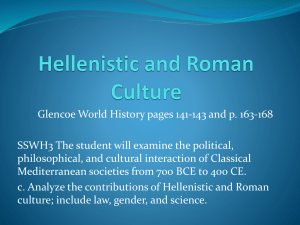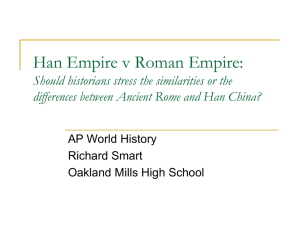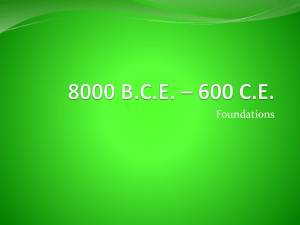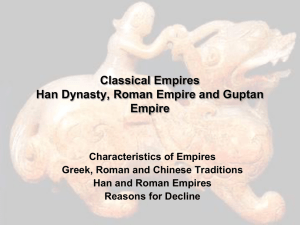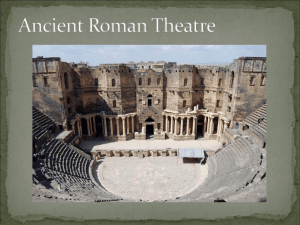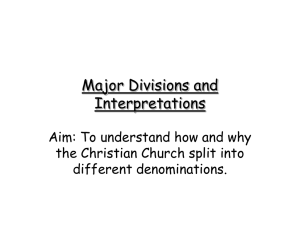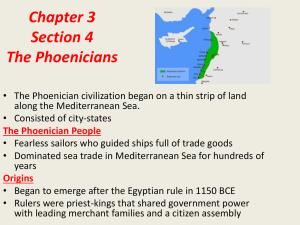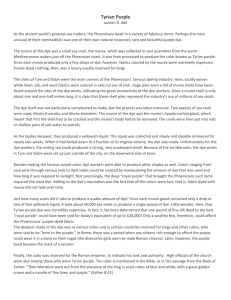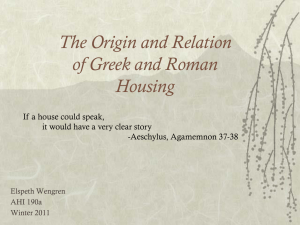The Med World
advertisement
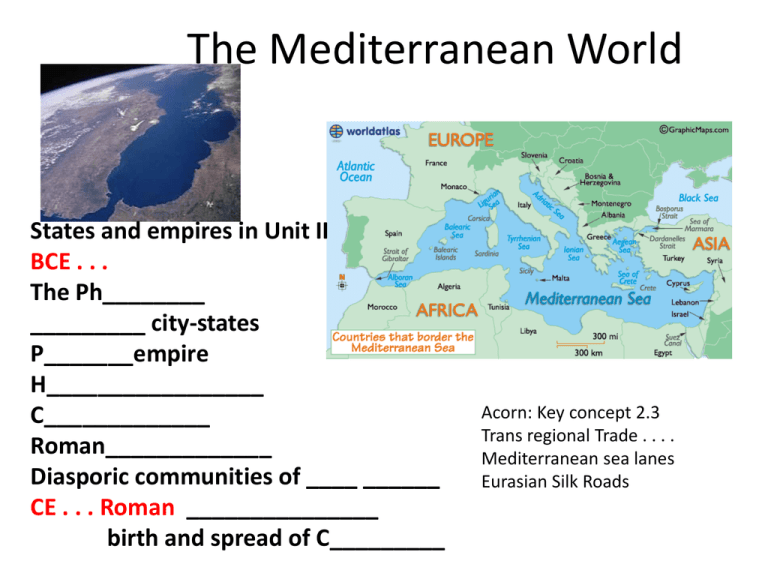
The Mediterranean World States and empires in Unit II BCE . . . The Ph________ _________ city-states P_______empire H_________________ C_____________ Roman_____________ Diasporic communities of ____ ______ CE . . . Roman _______________ birth and spread of C_________ Acorn: Key concept 2.3 Trans regional Trade . . . . Mediterranean sea lanes Eurasian Silk Roads What is the title? Hint it starts with a “c” The Phoenicians (1500–300 b.c.) The Phoenicians were masters of the s_______. Their economy was based on trade. Rather than moving goods over the land in massive caravans, the Phoenicians built large sailing ships. An early Phoenician coin, showing a Phoenician galley ship. An expert on the subject of Phoenician history and shipwright states: "Nor were these boats tiny. The galley fighting ships, with their rows of galley oars, could have a crew of over a hundred people ... But even those were small compared to the Phoenician cargo ships with their vast, rounded hulls. These ocean-going ships were built for huge loads and long hauls. They made the extended trips from Mediterranean ports out to destinations on the Atlantic Ocean coasts of Spain and Morocco .... CONTRAST Med ships to IO ships Innovations in maritime technologies, as well as advanced knowledge of the monsoon winds, stimulated exchanges along maritime routes from East Africa to East Asia. Teach one illustrative example of innovations in maritime technologies, either from the list below or an example of your choice: • Lateen sail • Dhow ships • Add east weast point from ap curriculum Greek city states . . . . And colonies One major reason why ancient Greece was dominated by small city-states and independent towns, rather than by one all-powerful king, is its geography. The country's mountainous terrain, many isolated valleys, and numerous offshore islands encouraged the formation of many local centers of power, rather than one all-powerful capital. And colonies Another key factor influencing the formation of citystates rather than kingdoms was the Mediterranean. Such a calm and easily navigable sea provided the Greeks with an opportunity to found new colonies in times of crisis and overpopulation. . . . .These colonies remained in contact with their mother cities, and acknowledged their 'blood ties' with them, but in most other respects they soon acted independently of them. See also http://www.eduplace.com/kids/socsci/ca/boo ks/bkf3/imaps/AC_12_389_citystates/AC_12_3 89_citystates.html Greek Golden Age . . . Date 5th century BCE Before or after life of Buddha, Confucius and Laozi? The Parthenon (/ˈpɑrθəˌnɒnˌ nən/; Ancient Greek: Παρθενών; Modern Greek: Παρθενώνας) is a temple on the Athenian Acropolis, Greece, dedicated to the goddess Athena, whom the people of Athens considered their patron. Construction began in 447 BC when the Athenian Empire was at the height of its power. It was completed in 438 BC although decoration of the building continued until 432 BC The number and size of key states and empires grew dramatically by imposing political unity on areas where previously there had been competing states. Required examples of key states and empires (Student should know the location and names): ,. . . Mediterranean region: Phoenicia and its colonies, Greek city-states and colonies, and Hellenistic and Roman Empires Hellenistic Era: Time period where Greek (and then Roman) culture spread and blended with civilizations conquered by A__________ the __________. The Hellenistic period is the period of ancient Greek and eastern Mediterranean history between the death of Alexander the Great in 323 BC and the emergence of the Roman Empire in 30 BCE. Greco-Buddhism, cultural syncretism between Hellenistic culture and Buddhism, developed between the 4th century BCE and the 5th century CE cultural consequence of a long chain of interactions begun by Greek forays into India from the time of Alexander the Great, carried further by the establishment of Indo-Greek rule in the area for some centuries, and extended during flourishing of the Hellenized empire of the Kushans. The convergence of Greco-Roman culture and Buddhist beliefs affected the development of unique sculptural developments. The Buddha, in Greco-Buddhist style, 1st-2nd century CE, Gandhara (Modern Pakistan). (Standing Buddha (Tokyo National Museum)). During the mid-3rd century BC, Carthage was a large city located on the coast of modern Tunisia. Founded by the Phoenicians in the mid-9th century BC, it was a powerful thalassocratic city-state with a vast commercial network. Of the great city-states in the western Mediterranean, only Rome rivaled it in power, wealth, and population. While Carthage's navy was the largest in the ancient world at the time, it did not maintain a large, permanent, standing army. Carthage and its dependencies in 264 BC The Punic Wars were a series of three wars fought between Rome and Carthage from 264 to 146 BC. At the time, they were probably the largest wars that had ever taken place.[ . . . . The Roman victories over Carthage in these wars gave Rome a preeminent status it would retain until the 5th century AD. Then . . . . ROME Mare Nostrum First a republic . . . And then an empire Dates? Roman provinces on the eve of the assassination of Julius Caesar, 44 BC The Pax Romana: The Roman Empire at its Height Concept 2.2, III C. Imperial societies relied on a range of methods to maintain the production of food and provide rewards for the loyalty of the elites. Teach one illustrative example of such methods, either from the list below or an example of your choice: • Corvee • Slavery • Rents and tributes • Peasant communities • Family and household production • Corvée unfree and unpaid labor imposed by the state for work on public projects or by a landlord • Early form of taxation • differs from chattel slavery in that the worker is not owned outright and the work is usually intermittent; typically only a certain number of days' or months' work is required each year. • Used by Imperial China , in the Egyptian Old Kingdom (ca 2613 BCE) for construction projects such as pyramids, temples, quarries, canals, roads, and in the Late Roman Empire the citizens performed opera publica in lieu of paying taxes in goods; often it consisted of road and bridge work. Slavery in China • Slaves (nuli 奴隸) comprised roughly 1% of the population, a proportion far less than the contemporary Greco-Roman world which relied on the labor of a large slave population. Slaves were classified into two categories: those who were privately owned, and those who were owned by the state Long banks of oars propelled the Roman warship swiftly through the water and into battle. Roman cargo ships featured the same distinctive square sails, but warships often had additional protective coverings to shield them from fire and missiles. Towns in the Diaspora The association of monotheism with Judaism was further developed with the codification of the Hebrew Scriptures, which also showed reflected the influence of Mesopotamian cultural and legal traditions. The Assyrian, Babylonian and Roman empires conquered various Jewish states at different points in time. These conquests contributed to the growth of Jewish diasporic communities around the Mediterranean and Middle East. The Spread of Christianity during 200400 A.D ________’s Missionary Activities The Fall . . . The Roman, Han, Persian, Mauryan, and Gupta empires created political, cultural, and administrative difficulties that they could not manage, which eventually led to their decline, collapse and transformation into successor empires or states. A. Through excessive mobilization of resources, imperial governments caused environmental damage (such as deforestation, desertification, soil erosion or silted rivers) and generated social tensions and economic difficulties by concentrating too much wealth in the hands of elites. B. External problems resulted from security issues along their frontiers, including the threat of invasions. (such as between Han China and Xiongnu; Gupta and the White Huns; or between Romans, and their northern and eastern neighbors)
